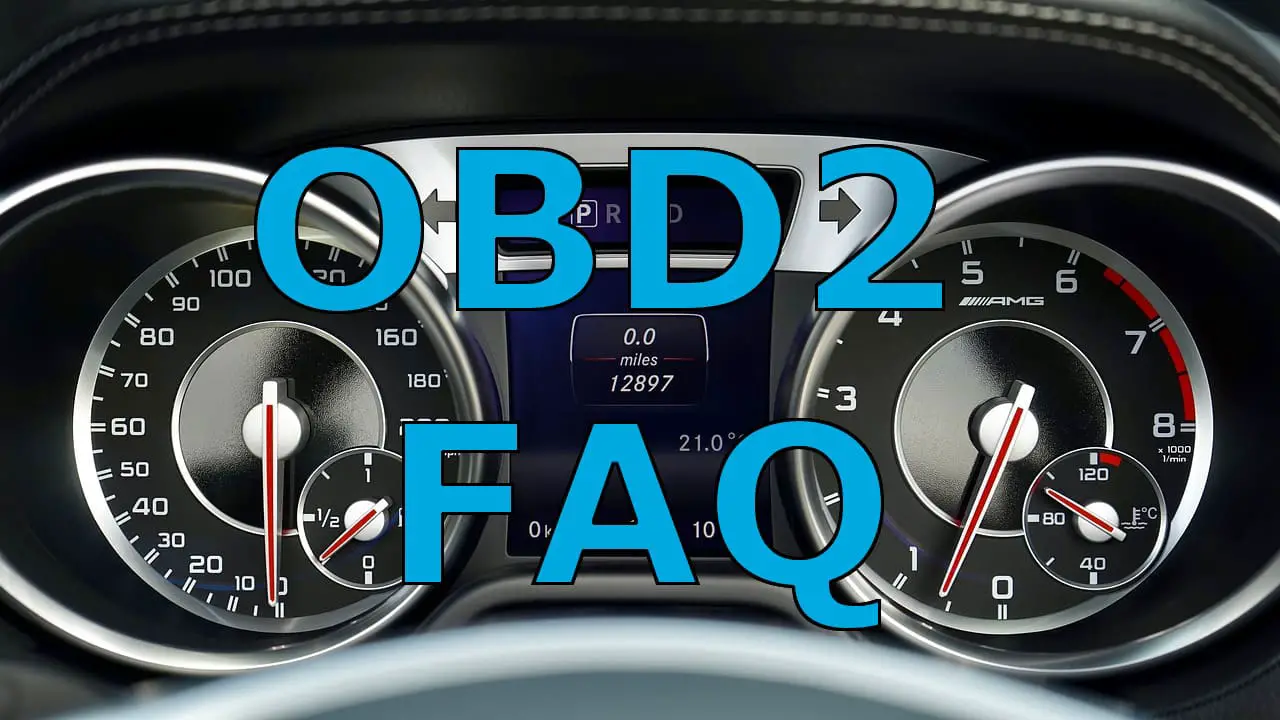
All About OBD2/II and EOBD
Matt here with ScannerAnswers and here we talk a lot about bluetooth obd2 adapters, wifi obdii scanners, and corded obd2 code readers. There’s a lot to learn when looking to invest in one of these tools and we get asked a lot of the same questions. So this guide is meant to help you get a better understanding of OBD2, what it’s useful for, and how it can help you fix your car or truck. Let’s dive into it 🙂
What does OBD2 mean?
OBD2 is the acronym for on-board diagnostics, second generation. You can deduce that it’s not the first of its kind and it will definitely have more spin-offs in the future. The name says it all, because the device helps vehicle owners determine which problems are influencing their cars’ performance.
What is an OBDII diagnostic tool?

In America, all cars since 1996 are legally required to contain these diagnostic systems. There’s no single type that sets the standard; different manufacturers use their own versions.
OBD systems have parts that are installed inside a car that pick up on problems. This part is called a DLC (data link connector). A DLC is a 16-pin connector. It’s installed in the dash area of a car, in such a way that you can easily reach it. Accessibility is essential to obtain future readings. Cars may need diagnostics done when:
- Emergency lights light up on the dashboard. The most prominent one is the MIL (malfunction indicator lamp). This means the installed OBD2 system picked up on a problem and you simply have to connect to it, so you can tend to the issue
- The car doesn’t perform as before. You may experience loss of power or low fuel efficiency. The information obtained via the OBD2 system can help you find the reasons for this
- The car doesn’t want to work at all
- When diagnostics are necessary, a diagnostic device must be connected to the DLC in the car. This diagnostic part of the system will produce:
- Codes referring to certain faults it picks up
- Procedures to follow to confirm and handle the situation
These diagnostic tools are available for use at any car dealership. You can imagine that using them may be costly, because those used by manufacturers are state of the art and highly specialized.
Luckily, simpler versions of these diagnostic tools are available. They can detect and diagnose problems, even if the information is not as detailed as the manufacturers.’ These tools are used by, sold by and rented out by car dealerships, local car technicians and specialized hardware stores.
You can attempt to diagnose your vehicle’s problems yourself, but remember you need knowledge of codes and diagnostic systems to do this accurately. Many diagnostic tools are sold on the market and if you’ve got the knowledge, it’s a perfect way to save money, since you don’t have to take your car to professionals.
Different types of on-board diagnostic: OBD1, OBD2, and EOBD
Over the years these tools have evolved. You probably have one of the following in your vehicle.
OBD1
In the early 1990’s the OBD1 (first generation) was developed. This system can be used for cars manufactured in that timespan. The OBD1 physically connects to the car. It can pick up faults and spew out codes that help vehicle technicians find the source of a problem.
OBD2/II
Cars manufactured after 1996, however, are compatible with the OBD2 systems. These systems are miles ahead with technology when compared to the OBD1 systems.

Firstly, the car doesn’t even have to be connected to the diagnostic device. The device connects via Bluetooth and provides codes signaling problems.
In addition to giving problem codes, the diagnostic device actually guides you—or the technician—through processes to troubleshoot, confirm and handle the problem.
OBD2 systems also give information regarding a car’s emissions. Since there’s a global movement to prevent unnecessary emissions, this is an essential function of OBD2s. You can check whether your vehicle is functioning in line with legislation and whether there’s anything you can do to keep your carbon footprint as low as possible.
EOBD
As mentioned, there’s not one standard OBD system and in 2001 the European Union decided to develop their own approach. The EOBD (European on-board diagnostics system) is required in all petrol vehicles since 2001 and in all diesel cars since 2004. These systems are more advanced than the original OBD systems, but is much the same as the OBD2.
OBD1 or OBD2? How do you tell?
So you want to use these exciting features, but you’re not sure whether your car has an OBD1 or OBD2 fixture? Try one of these methods to confirm:
A general rule is that any car manufactured after 1996 will have an OBD2 system. This may be problematic if you own a car which doesn’t have its original engine. Use one of these tests then:
The distributor plug-ins differ
- OBD1 systems require 8 wires
- OBD2 system have 4 wires
The distributor’s holes differ
- An OBD1 system will have 3 oval holes
- An OBD2 system will have 1 round hole and the rest will be oval
The map sensors are in different places
- If it’s on the firewall, you have a OBD1 system
- If the map sensor is on the throttle body, your system is OBD2
There are quite a few differences between the systems. You can see that some technical background is needed so you can find these differences. You may want to ask a professional to help you if you’re still not sure.
OBD-II vehicle protocols
While it’s a standard requirement that vehicles must have an OBD system, how they work is not yet standardized. Each OBD system will use one of 5 available protocols.
What is a protocol?
A protocol is basically the way in which your vehicle’s system communicates data. As soon as you plug in your OBD system’s diagnostic tool (via physical connectors or Bluetooth), it will tell you which of these protocols are in place.
There are different protocols, since manufacturers apply their personal opinion and preferences when designing systems. Each company thinks it has a better way of performing a task, which results in different protocols which all basically do the same thing.
Each of the protocols use different pins on the DLC from which to draw information. If you want to understand the information your vehicle’s OBD system delivers to you, you need to know which of the following methods is used.
Types of protocols
Protocols differ in the speed they communicate and the pins they use to acquire and deliver information. If you know the rules set out below, you can determine which protocol your vehicle uses, simply by looking at the pins that are activated on your DLC. Not all protocols will support all the codes used by manufacturers.
Below you’ll find the 5 most common obd2 protocols:
SAE J1850 PWM
- Download speed is 41.6 kB/sec
- Must have pin 2 & 10
- This protocol is widely used in Ford vehicles
SAE J1850 VPW
- Download speed is 10.4 kB/sec
- Must have pin 2
- Many GM vehicles use this protocol
ISO 9141-2
- Download speed is 10.4 kB/sec
- Must have pin 7 & 15
- This is most likely to be present in Asian and European cars
ISO 14230 KWP2000
- Download speed is 10.4 kB/sec
- Must have pin 7 & 15
- Once again, widely used in Asian and European vehicles
ISO 15765 CAN
- Download speed is 1Mb/sec
- Must have pin 6 & 14
- American vehicles that are manufactured after 2008 should work with these protocols
If you want to use your OBD2 system effectively, you must know which system is used, be able to understand the feedback, and know how to handle the problems. This calls for a lot of homework, experience and even the assistance of professionals in some cases.
All about the DTC codes
If you think you know enough to repair minor faults in your car, you can try out a diagnostic tool. Remember you can connect the diagnostic tool to your car via Bluetooth. Technology has advanced so much, that even smartphones can now be used as diagnostic tools.
A code reader will scan your engine and display DTC (Diagnostic Trouble Codes) data. Find a complete list of DTCs here.
You can then attempt to fix the problem, diagnose again and see if you can clear the code. This will be proof that you’ve done the right thing and your vehicle will perform better in future.
If your diagnostic tool is advanced enough, it will give you codes along with some more detail such as repair processes, to take some guess work out of the process. Let’s look at some basic guidelines that may help you.
OBD2 trouble (or fault) codes
Diagnostic trouble codes (DTC) are mostly standard; they are also called fault codes. Even if the OBD2 systems aren’t standardized, some of the information they spew out should be. These facts may help you assess whether you need professional help.
View a full list of OBD2 trouble codes here: https://www.obd-codes.com/trouble_codes/
Each item in the code refers to a certain part of the vehicle and fault. If you get to know the references, you can make your diagnosis faster.
- Powertrain codes start with a P
- Body problems will give a code starting with B
- If the issue lies in the chassis, you’ll see a code with C
- If there are problems in the wiring, expect a code starting with U
Each digit after the letter refers to a certain area or fault
- If a code starts with P1, it’s usually manufacturer specific. You’ll need to investigate some more to know its meaning. A zero indicates standard OBD codes
- The next digit refers to the area of the car you need to investigate. As an example, 00 relates to fuel, air and emissions. 03 will direct you to the ignition system.
- The last 2 digits concern the actual fault
OBD2 PIDs
Apart from waiting for trouble codes, the diagnostic system allows you to obtain certain information from your vehicle. A PID (parameter ID) code can be submitted to the diagnostic system via a scan tool connected to the OBD2 system. The system searches for the appropriate information and then reports back to you or the technician. Information that can be obtained, includes:
- Information from sensors such as some cars’ oxygen monitoring systems
- Pressure levels
- Temperature levels
- Distance traveled since the last time codes were cleared
- The position of certain parts e.g. throttles
Many more statistics can be pulled from your vehicle’s system. These can be used to determine the current efficacy of your engine. Adjustments can be made so the engine can function better. The readings will show you which areas of the engine are under pressure. You can repair or replace parts so the overall running of the engine benefits.
Not all codes are standardized, and some codes only pertain to certain vehicles. There are many codes you can type in and also different modes. Modes include:
- Current data
- Freeze-framed data
- Pending trouble codes
- Basic vehicle information
- Test results
Ask an experienced technician for assistance if this process seems daunting. You don’t want to damage your vehicle or misunderstand the information.
Conclusion
An OBD system is compulsory in many countries, and with all this information you can see the benefits of having one in your vehicle. You can make sure your vehicle functions well and tend to problems whenever they arise. If you have the resources and the knowledge, obtain your own diagnostic tool today. Alternatively, stand by when your vehicle technicians work with them. You may pick up enough practical knowledge to use one yourself in future.